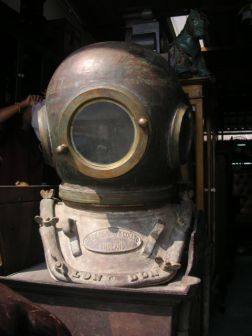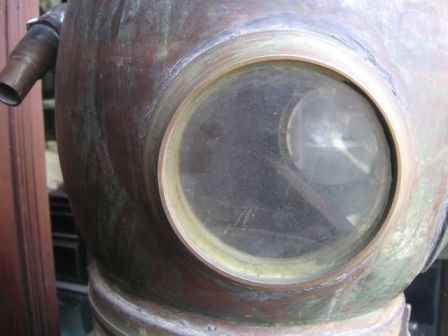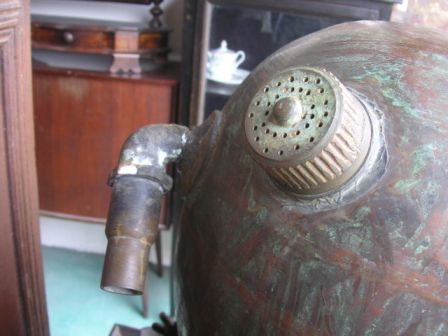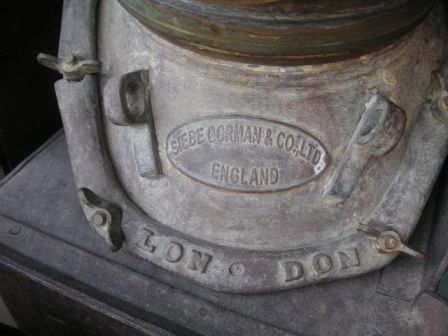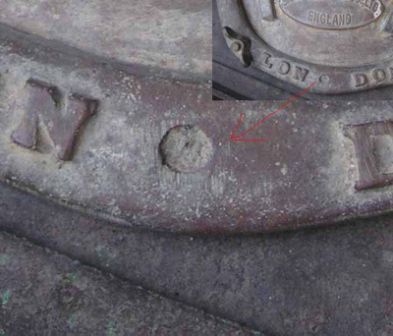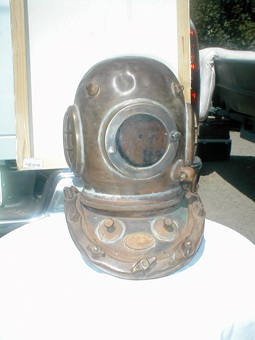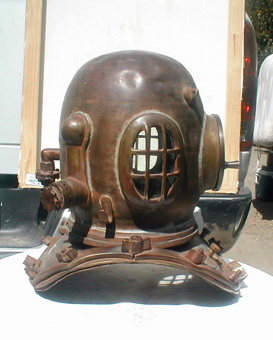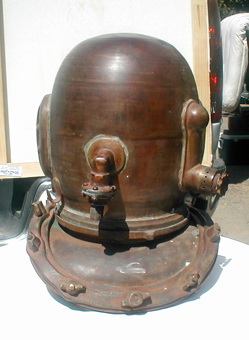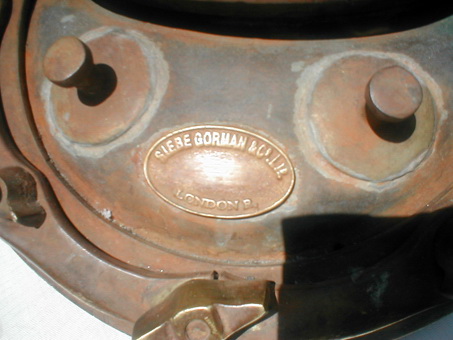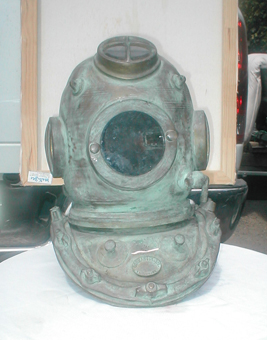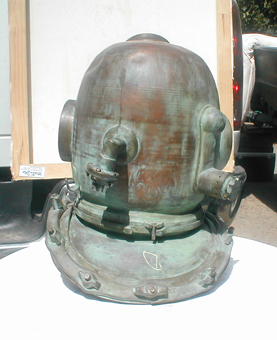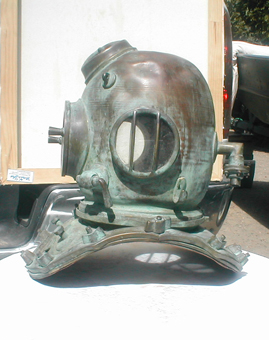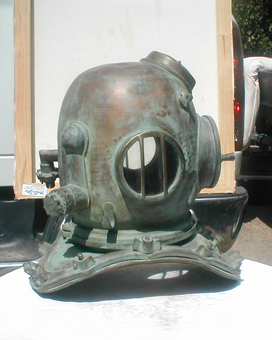Siebe Gorman
THE SIEBE GORMAN 12-BOLT REPRODUCTION
HELMET (ALSO KNOWN AS THE ‘INDIAN FAKE’, OR ‘MUMBAI COPY’)
By MIKE BURCHETT
(Photos & graphics: Robert Burchett)
THE BACKGROUND STORY
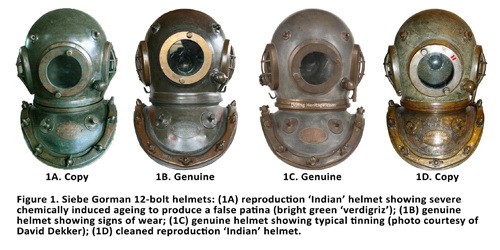
This very good ‘Indian’ reproduction of a Siebe Gorman 12-bolt helmet has a
short, but interesting background (figures 1 and 3). It serves as a reminder
that “if one person can make it, so another person can fake it” (given enough
helmet knowledge and craft expertise). The reproduction helmet initially
deceived some experts and one or two helmets even passed through auction houses
as the genuine item.
The helmets started to appear on the UK market during the summer and autumn of
2005. The first batch of several helmets arrived in the UK from India, and most
helmets were quickly sold to eager buyers. The helmets were in near perfect
condition, all looked nearly identical and most had serially matched part
numbers (on helmet, corselet, faceplate and brails). Serial numbers between the
helmets were also sequentially close. The story told at the time was that the
helmets were part of a consignment destined for British colonial salvage
operations in the 1950s, but were rarely used, put into storage, and
subsequently re-discovered.
A few months later, a second batch of about 12 helmets became available from the
same source in India. Once again, the helmets were all very similar in looks to
those from the first batch, and many carried serially matched part numbers.
Serial numbers between the helmets was again sequentially close. However, as a
set of circumstances like this is “too good to be true”, the proverbial ‘alarm
bells’ started to ring. Some helmets from the second batch were closely examined
and found not to be genuine, but instead were very good forgeries. Following
this, the actions of the UK supplier was most commendable. The fraud was swiftly
and publically exposed, and the UK supplier acted in an honest and appropriated
manner to rectify the situation.
It is now known that these batches of reproduction helmets (together with other
Siebe Gorman apparatus and marine artefacts) were manufactured in northern India
by the same family of artisan craftsmen that still make them today (2010). These
reproduction helmets and other copy items are still being sold worldwide through
the internet to unsuspecting buyers, by a well known Mumbai exporter.
Unfortunately these fraudulent helmets are sometimes realising genuine helmet
prices, but as a fraudster knows, a very good copy is still only worth a
fraction of the price, compared with the genuine item.
As these reproduction helmets become more widely known, other ways are being
found to pass them off or sell them on. Some helmets are now being marketed
without the tinned surface (the tinning is removed and the surface mirror
polished). Other helmets may have air ducts, the maker’s name tag and serial
numbers missing altogether. It probably won’t be long before the first quality
reproduction 6-bolt helmet arrives on the market, so be vigilant!
It is unclear whether the reproduction ‘Indian’ helmet can be dived because of
some small, but significant differences. However, it would seem unwise to risk
diving with an incomplete helmet of dubious origin which may have components
made from poor quality, sub-standard materials.
THE REPRODUCTION HELMET
To the unsuspecting buyer or to an untrained eye, the Siebe Gorman reproduction
helmet can be difficult to distinguish from a genuine example (figure 1).
However, once several of these helmets have been closely examined, many little
differences soon become apparent, and the helmets become quite recognisable. If
a complete list of these differences were provided in this article, it is
possible that the forgers will just improve the next batch of forgery helmets.
Therefore, just a few of the most easily recognisable differences are given
here, which should be sufficient for a collector to identify the reproduction
helmet. Some information has already been published on the excellent French
website dedicated to historical diving apparatus. However, unless you speak the
language, the information may not be clearly understood. Hopefully this article
in English will help those of us with limited language skills.
Serial Numbers
Siebe Gorman helmet serial numbers are normally found on the underside of the
brails, the faceplate (but not always), inside the helmet neck ring and inside
the corselet ring. The five digit serial numbers on reproduction helmets mostly
start with ‘192’ (plus two following numbers). Sequential serial numbers for the
reproduction helmets start around ‘19250’ and approach ‘19299’. Therefore it is
possible that up to fifty reproduction helmets may have been made to date. In
addition, a few reproduction helmets have now been noted with serial numbers in
the early ‘193XX’ range (helmet 19312), which may suggest that more reproduction
helmets are being produced. Some genuine Siebe Gorman helmets and helmet parts
that carry serial numbers between ‘19250’ and ‘19312’ are known to exist, which
confirms the fraudulent nature of the reproduction helmets.
Some Feature Differences
When examining a potential reproduction helmet, a single comparative difference
should not be taken in isolation as proof of a forgery. If possible, a number of
distinctive and unique differences should be identified to produce a strong case
that the helmet is in fact, not genuine.
GENERAL APPEARANCE: an
overall appearance of a helmet should look correct for its age. The ‘Indian’
reproduction helmets do not appear correct, as they are all too perfect and look
too similar for their age (figures 1A and 1D). Few helmets are in perfect
condition and most carry signs of wear associated with their past use (figure
1B)
MAKER’S NAME TAG: the
maker’s name tag on the corselet is always worth comparing with a genuine one of
the same style and from the same period. A comparison should be made with an
authenticated helmet that has a serial number close to that of the helmet under
suspicion. The ‘Indian’ reproduction name tag is an excellent copy, and there
are few noticeable differences, apart from a slight size discrepancy and
inadequate soldering of the tag to the corselet. As an exercise to “train the
eye”, there are a number of noticeable differences between the ‘Indian’
reproduction name tag, and an original one with a slightly different style of
lettering shown in figure 2.
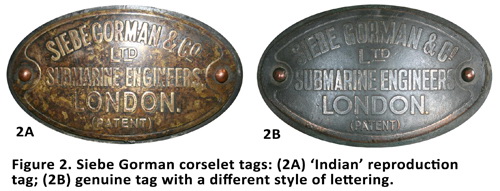
Look closely and you will begin to appreciate a number of subtle differences
between the two name tags.
TINNING: the quality of
tinning is poor and quite patchy on some surface areas of the reproduction
helmets. The most obvious difference is in the ‘patina’ of the tinned surfaces.
The reproduction helmet surfaces have been artificially aged with chemicals, and
later tests suggest that an ammonia containing treatment (perhaps equine urine)
may have been used. This chemical appears to have been brushed on to the
surfaces of the helmet, giving the tinned areas a characteristic ‘streaky’
appearance (figures 1D and 3A-3E).
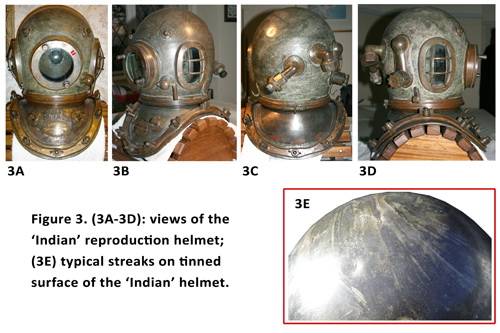
Compare this to the typical well tinned surface of a genuine helmet (figure 1C).
COLOUR: bright green,
copper containing corrosion deposits (verdigris) often appear over wide areas of
the reproduction helmet surfaces (figure 1A), and in some areas where they
should not normally be expected (figure 7A). Most genuine helmets have some
‘verdigris’. However the ‘verdigris’ deposits on a reproduction helmets can be
relatively thick and scaly, and the deposits flake away too readily.
SOLDERING: the quality of
the soft soldering is often poor where brass fittings are attached to the copper
helmet or corselet. The soft solder join around the perimeter of the
reproduction corselet often appears ‘ripple-like’ instead of ‘smooth’ (figure
4).
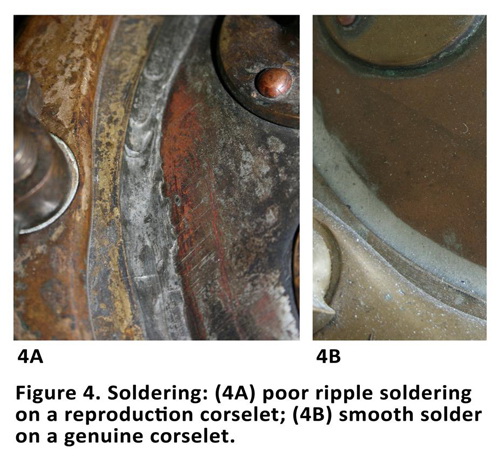
Slotted stud heads on the underside of the corselet are often left un-tinned on
reproduction helmets (figure 6B).
FITTINGS: the air inlet
elbow of the reproduction 12-bolt helmet uses a standard 6-bolt elbow fitting
(nut-shaped), instead of the more typical round-shaped one, that is seen on most
(but not all) 12-bolt helmets (figure 5).
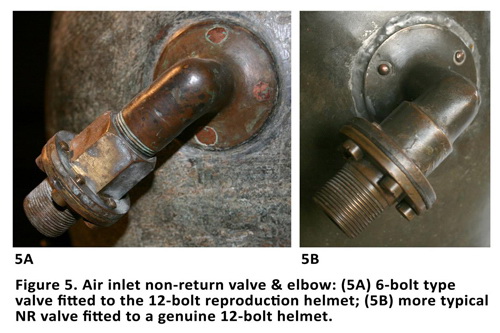
Quite often, threads of various reproduction fittings (e.g. air inlet,
faceplate, corselet studs etc.) will not allow accurate fitting of genuine
parts. Position of rivets can also differ and some rivet heads may be ground off
or flattened on the reproduction helmets.
AGEING: apart from the
induced ageing of reproduction helmet with chemicals, false distressing is
sometimes observed on surfaces and edges. This is often applied by hammering or
filing (figure 6A).
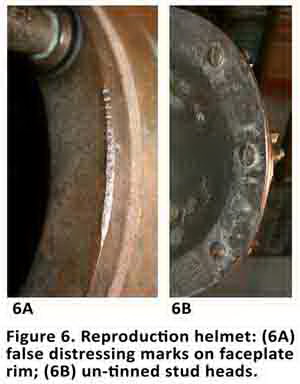
HELMET COMMUNICATIONS: a reproduction helmet may have parts of the
communication system left inside the bonnet to add authenticity. Sometimes the
wiring may appear old, but quite often bright new, red and black ‘PVC’ coated
cable is used (figure 7B).
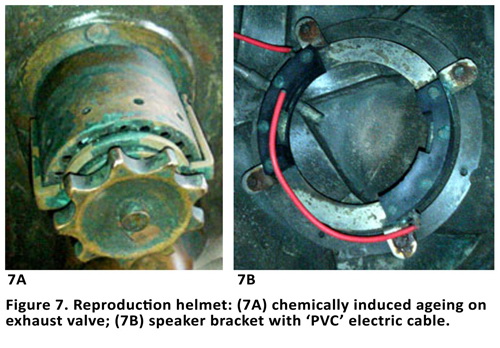
Finally, temper buying enthusiasm with caution and approach every helmet as a
potential forgery. Knowledge and experience are your only real allies, and it
can be a steep and sometimes expensive learning curve for the unwary buyer. Even
an expert is occasionally deceived by a forgery. If a helmet appears “too good
to be true”, then it probably is. The Latin phrase ‘Caveat emptor’, “Let the
Buyer Beware” is one worth remembering.
ACKNOWLEDGEMENTS
I would like to thank David Dekker, Dr. John Bevan and Phil Thurtle for their
helpful comments and suggestions while writing this article.
With special thanks to Mike Burchett for this article
'CONTINENTAL' REPLICA OF THE
SIEBE-HEINKE, 3-BOLT (4-light)
'LIGHTWEIGHT HARBOUR HELMET'
INTRODUCTION
The Heinke 3-bolt 'Lightweight'
Harbour Helmet and corselet (with top glass/light) was produced by C.E. Heinke &
Co. Ltd. mostly during the post war period (Code No. 2/B1014). However, in 1961
the Heinke Company was taken over by the firm of Siebe, Gorman & Co. Ltd. who
then continued to produce the 'Lightweight' Harbour Helmet under their own name
for several more years, but with a few minor changes (including the Siebe,
Gorman style spitcock and their own oval name badge). In essence Siebe, Gorman
was using up the Heinke parts they had acquired during the takeover for the
continued manufacture of this helmet.
The replica version of the
English 3-bolt (4-light) lightweight 'Harbour Helmet' has been in circulation
since mid-2010, and the helmet is found with a Siebe, Gorman company name badge
on the front of the corselet (breastplate). It is worth noting that authentic
3-bolt (4-light) Siebe-Heinke 'Harbour Helmets' are rare, therefore finding an
inexpensive, genuine helmet is most unlikely.
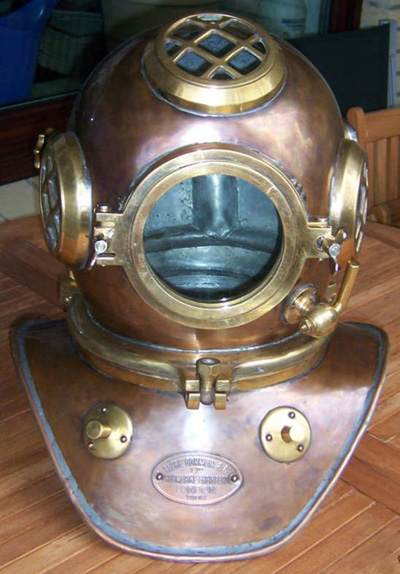
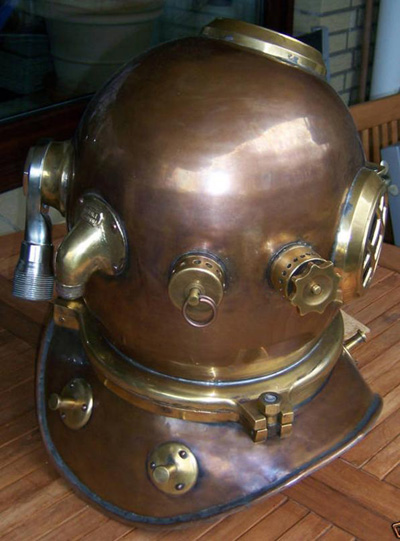 |
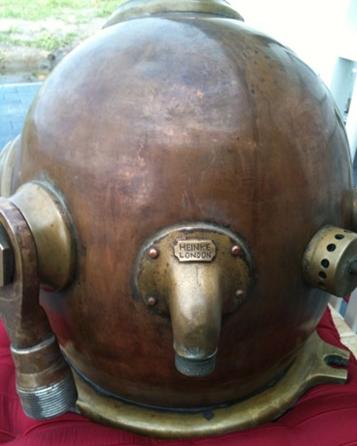 |
|
Rear view
of two of the replica helmets
THE
BACKGROUND STORY
The history
of this replica helmet is an interesting tale of intrigue and more
details are likely to emerge in the forthcoming years. On 27th January
2009 a burglary took place in the German town of Lorsch where some 28
diving helmets were stolen from a private collection (including a Heinke
'Lightweight' Harbour Helmet). The German police were informed about the
stolen helmets and an investigation was carried out. A number of the
stolen helmets were advertised on the police website. Three days after
the robbery, 12 of the stolen helmets were offered for sale by a German
dealer to a Belgian collector. Nine of these helmet were then purchased
by the collector. However soon after the deal was concluded the Belgian
collector became uneasy at the low prices offered for some of the
helmets. Therefore the collector contacted a known diving apparatus
dealer from Wassenaar in the Netherlands for some advice. A meeting was
arranged for the following day which took place in Belgium between the
various parties. The helmets were identified as being part of the stolen
collection. The helmets were returned to their rightful owner but the
unfortunate Belgian collector had lost his purchase money.
A few weeks
later, German police arrested a German father and son for the burglary
and theft of the diving helmets. The arrested men were also known to be
responsible for previously organizing the manufacture and sale of
forgery Draeger diving helmets. The court case was due to be heard at
Freising, Germany on 24th October 2011, some two years after the robbery
occurred, but the case was postponed.
The web of
intrigue deepened in June 2011 when one of the two men originally
arrested for the helmets theft offered a Dutch collector a rare
Siebe-Heinke 3-bolt (4-light) 'Lightweight' Harbour Helmet and then
accepted a very low offer. The helmet was purchased, but the collector
was suspicious as to why the helmet was sold at a knock-down price.
Having known about the robbery some two years previously and suspecting
the seller may be connected in some way, the collector looked through
the 'Polizei' website database which illustrated the stolen helmets. He
also contacted a reputable diving apparatus dealer/collector near Hoorn
in the Netherlands for some further advice. A comparison was made
between the newly bought helmet and photographs of the original stolen
one. From the outcome it was evident that the newly purchased helmet was
not the original stolen helmet, but nor was it a genuine one! It was in
fact a good replica which had then been sold as a forgery by one of the
previously arrested men.
It is now
thought that the original Heinke 3-bolt (4-light) 'Lightweight' Harbour
Helmet stolen from the German collection was most likely dis-assembled,
parts were copied and from this a number a fake helmets were
manufactured (but instead the replica helmets are fitted with a Siebe,
Gorman company name badge on the front of the breastplate). However as
to the final quantity of helmets reproduced, only the forgers know. The
source of the manufacturing operation is likely to have been Poland,
(possibly near Gdynia) where past reproduction helmets have been made
and from where there is easy distribution links to the rest of Europe.
Less than
two months later (early August 2011) another reproduction helmet
identical to the first one surfaced onto the market and was offered to a
German collector by a Polish woman who spoke excellent German.
Photographs of the helmet were sent, but the collector took further
advice and luckily he did not purchase the fake helmet. Following on
from this, fake helmets has been sold in Denmark, to a diving museum in
Holland and one has been offered for sale by a dealer in Bristol (UK).
These
Siebe-Heinke helmets first came onto the market around June 2010 when
one was offered for sale on the major internet USA website. The German
dealer did not pretend to sell the helmet as an original, but as a
replica which is quite legitimate. However when contacted he would not
reveal the source of this reproduction helmet! It should be remembered
that a dealer who sells a replica of a vintage diving helmet is not
breaking the law if it clearly states that the helmet is a copy, replica
or reproduction. However if the helmet is advertised and sold as
authentic (e.g. made by the original manufacturer) when it is clearly
not (therefore there is obvious deception by the seller), then this act
becomes fraudulent because the helmet is now a forgery.
Unfortunately to date, 16 helmets from the original collection are still
missing, including the Heinke 3-bolt (4-light) 'Lightweight' Harbour
Helmet. It is not known if other types of helmets have been copied and
are ready to enter the market place in the near future, so watch out.
SOME
MAJOR DIFFERENCES
When
examining a potential reproduction helmet, a single comparative
difference should not be taken in isolation as proof of a forgery. If
possible, a number of distinctive and unique differences should be
identified to produce a strong case that the helmet is in fact, not
genuine. At first sight the reproduction 'Lightweight' Harbour Helmet
looks quite convincing, but there are several noticeable differences:
Helmets are not tinned (most genuine ones were tinned or show some signs
of original tinning).
Some helmets appear as if they are manufactured yesterday, and look far
too new.
Build quality is not as good when compared to a genuine helmet.
Some of the helmets may have a chrome-looking, swivelling telephone
connection (banjo).
Position of the 'diver-phone' stamped word on the telephone connection
is not correct and the serial number may be missing underneath this
word.
Serial numbers may be missing from the helmet, corselet and other
normally marked parts.
Makers name badge (of the Siebe Gorman type) that is attached to the
front of the breastplate is not correct.
Position of certain fittings are not correct or are not at the correct
angle and rivet heads may also be wrongly positioned. A careful
comparison should be made of these as they are obvious give-aways.
Helmet bonnet looks to the left a little when fitted to the corselet
(breastplate), therefore it is slightly out of line.
Hopefully
the above differences and the photos are enough to make people aware of
the reproduction helmets. There are several other small, but significant
features that distinguish the fake helmet from a genuine one. However a
comprehensive list of differences given here will only make the forgers
work easier if another batch of helmets are produced. |
Special thanks again go to Mike Burchett.
Morse
|
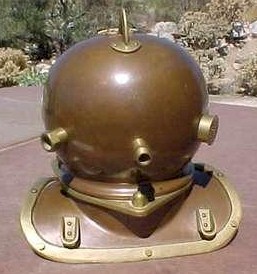
|
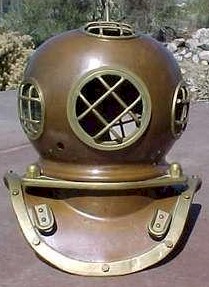
|
|
Have a look
at this 4 light item. Is it a 3 bolt ? NO ! Is it a 12 bolt ? NO !, it's
Super Grover !! It looks like a Draeger and it looks like an old Morse helmet.
In the right picture you see a hole. Maybe our phony friends planned an
exhaust there. Remember this is not a diving helmet and you should not
have to pay a diving helmet price for it. |
US NAVY MARK V
Probably the most replicated
diving helmet in the world is the Mark V. The latest copies sometimes even have
airducts and the interrupted screw thread! Be aware, before you know it you pay
a real helmet price for a phony hat.
|
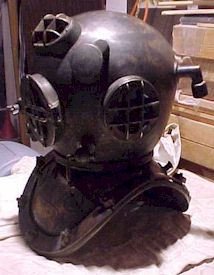
|
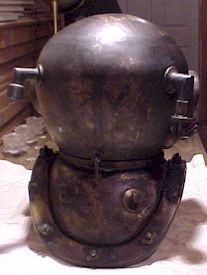
|
|
This
interesting item circulated the worlds biggest marketplace for a while. It
is a US Navy Mark V from 1909. Now, that's interesting because George D.
Stillson finished the design for the Mark V around 1915. This item was
first offered as a real helmet and later as a reproduction. One of the few
we have ever seen with nipples on the front and the back of the corselet. |
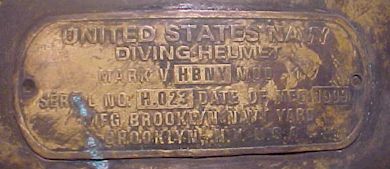 |
|
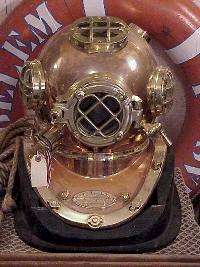
|
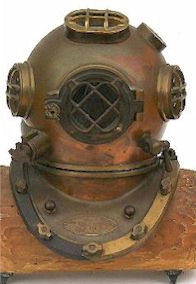
|
|
From the MARK V
a lot of reproductions were made
(and still are). Sometimes it is hard to tell
the repro
from the real thing !
|
The best replica
of the MARK V is the so called "8-29-41" that was made in Taiwan in
1980.
|
|
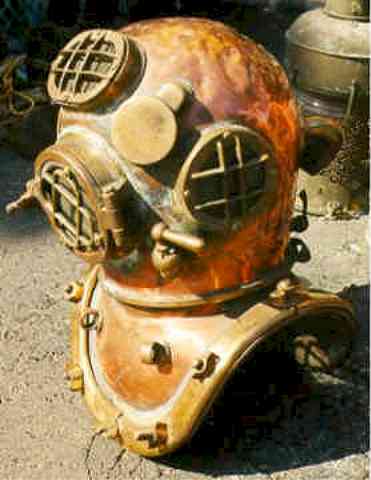
|
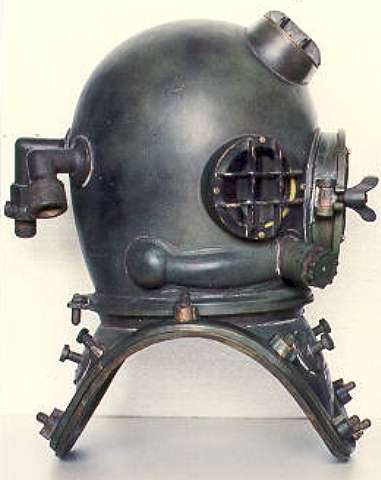
|
|
Korean MARK
V replica. The position of the phone booth
is not bad compared to many other phonies but have a look
at the spitcock. |
English MARK
V Replica.
It has an eight point exhaust handle but no holes
at the end of the banana tube !
|
|
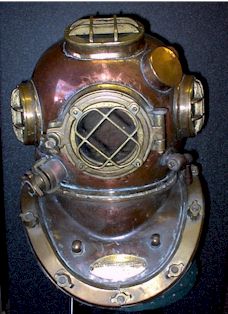
|
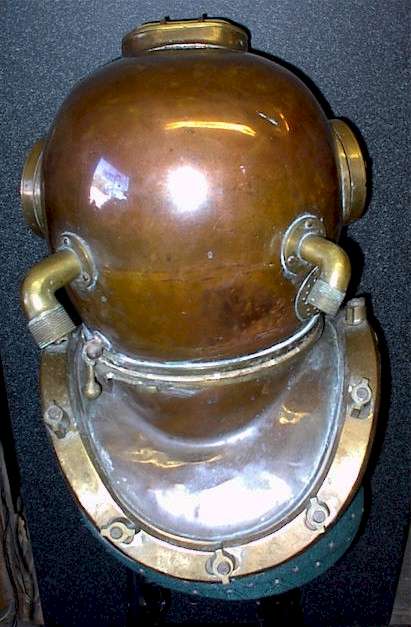
|
| One
more for the road ! You will sometimes be offered this 8-29-41 reproduction
with actual numbers beeing punched in the nametag. Do not fall for that
trick. |
Nametag
|

Morse used OVAL nametags.
This one is a reproduction that has NO number stamped in it. |
 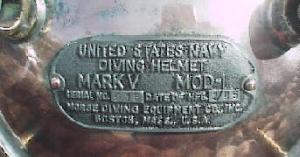
|
|
|
Two original name tags:Schrader
used this shape |
Another one trying
to fool us!! You remembered to look at the nametag. Then you find a beautiful
SCHRADER Mark V helmet on Ebay (at least: that is what you think) and start
bidding like there is no tomorrow.
|
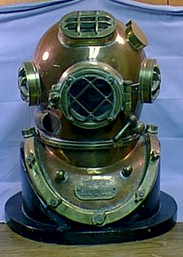
|
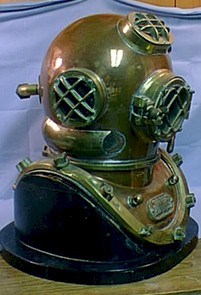
|
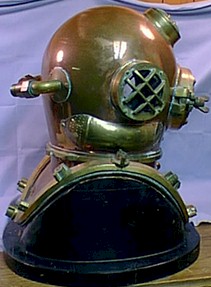
|
|
We
find the position of the air-inlet and the phone-connector rather strange:
they must be in each others way. The telephone booth on this hat is,
compared to real Mark V's, put way to far to the back. The top light seems
to be a bit too far to the left. The mechanism to adjust the air-outlet is
missing. There seems to be no hole to the inside of the helmet. Conclusion
? Nice try with a custom made nametag. Schrader NEVER used screws.
Nametages were always SOLDERED. |
|
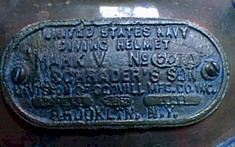
Did you know people even offer
phony nametags for sale?
This looks like a bad recast from an original one.
|
|
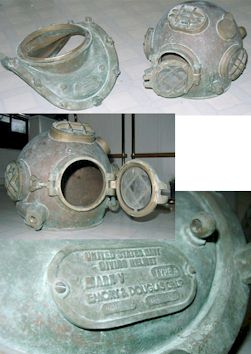
|
Ever heard of
the EMORY & DOUGLAS company producing Mark V diving helmets? As far as
we are concerned they are in the phony business! Sold on Ebay for a real
diving helmet price...... |
|
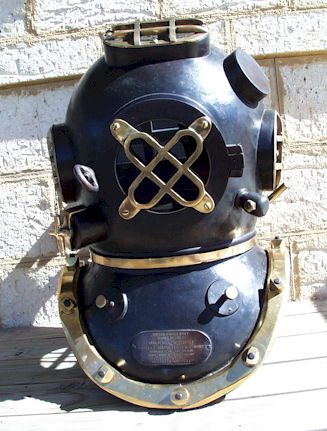
|
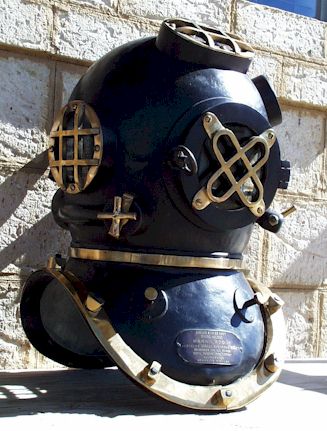
|
|
Dear
Karin and Bert. I bought this helmet in an Indonesian antique shop. The
salesman was honest about the fact it was obviously fake. It cost
2,000,000 rupiah which is less than USD200. I think this to is a fair
price for an ornament considering material and the level of workmanship.
The helmet is copper/brass, including the shell which has been blackened.
The valves function but the pipe fittings are blank. The spelling mistake
(incoperated) on the label tag is particularly amusing!
I would be interested in your comments and feel free to use the pics I
have sent
Also a friend "assures" me that fully functional MkV
replicas are available in China. He has worked with Chinese divers and he
says there are still used today and can be purchased for about USD500. Do
you think this true?
Bob Griffiths
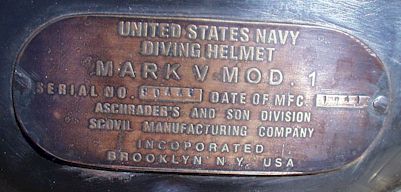
Who knows
more about Chinese, fully operational MkV's? Please contact
us |
See
more phony material
- Last edited on 25th February 2014










